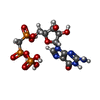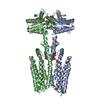+Search query
-Structure paper
| Title | A c-di-GMP signaling module controls responses to iron in Pseudomonas aeruginosa. |
|---|---|
| Journal, issue, pages | Nat Commun, Vol. 15, Issue 1, Page 1860, Year 2024 |
| Publish date | Feb 29, 2024 |
 Authors Authors | Xueliang Zhan / Kuo Zhang / Chenchen Wang / Qiao Fan / Xiujia Tang / Xi Zhang / Ke Wang / Yang Fu / Haihua Liang /  |
| PubMed Abstract | Cyclic dimeric guanosine monophosphate (c-di-GMP) serves as a bacterial second messenger that modulates various processes including biofilm formation, motility, and host-microbe symbiosis. Numerous ...Cyclic dimeric guanosine monophosphate (c-di-GMP) serves as a bacterial second messenger that modulates various processes including biofilm formation, motility, and host-microbe symbiosis. Numerous studies have conducted comprehensive analysis of c-di-GMP. However, the mechanisms by which certain environmental signals such as iron control intracellular c-di-GMP levels are unclear. Here, we show that iron regulates c-di-GMP levels in Pseudomonas aeruginosa by modulating the interaction between an iron-sensing protein, IsmP, and a diguanylate cyclase, ImcA. Binding of iron to the CHASE4 domain of IsmP inhibits the IsmP-ImcA interaction, which leads to increased c-di-GMP synthesis by ImcA, thus promoting biofilm formation and reducing bacterial motility. Structural characterization of the apo-CHASE4 domain and its binding to iron allows us to pinpoint residues defining its specificity. In addition, the cryo-electron microscopy structure of ImcA in complex with a c-di-GMP analog (GMPCPP) suggests a unique conformation in which the compound binds to the catalytic pockets and to the membrane-proximal side located at the cytoplasm. Thus, our results indicate that a CHASE4 domain directly senses iron and modulates the crosstalk between c-di-GMP metabolic enzymes. |
 External links External links |  Nat Commun / Nat Commun /  PubMed:38424057 / PubMed:38424057 /  PubMed Central PubMed Central |
| Methods | EM (single particle) / X-ray diffraction |
| Resolution | 1.9 - 3.2 Å |
| Structure data | EMDB-37444, PDB-8wcn:  PDB-8wct: |
| Chemicals |  ChemComp-G2P:  ChemComp-MG:  ChemComp-GOL:  ChemComp-HOH: |
| Source |
|
 Keywords Keywords |  MEMBRANE PROTEIN / MEMBRANE PROTEIN /  GGDEF domain / GGDEF domain /  diguanylate cyclase activity / CHEASE4 domain / iron-sensetive diguanylate cyclase activity / CHEASE4 domain / iron-sensetive |
 Movie
Movie Controller
Controller Structure viewers
Structure viewers About Yorodumi Papers
About Yorodumi Papers






